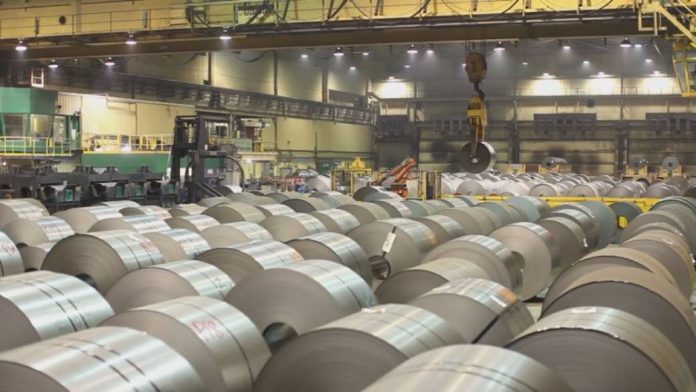“Common sense prevailed.”
That’s what Deputy Prime Minister and Finance Minister Chrystia Freeland says turned the tide in the latest Canada-U.S. trade dispute over Canadian aluminum exports to the south.
“The last thing that Canadians and Americans need in the middle of this pandemic is another trade war.”
The United States said Tuesday it would drop 10 per cent tariffs on $3.6 billion worth of imported Canadian aluminum products, just two hours before Canada was set to unveil its own tit-for-tat list of retaliatory penalties against American imports to this country.
In a statement U.S. Trade Representative Robert Lighthizer walked back tariffs the Trump administration had slapped on non-alloyed Canadian aluminum in August, saying he expects that surging Canadian imports are “likely to normalize” or level out in the second half of this year and through the first part of next year.
Trump’s tariffs had taken effect in August. Their withdrawal is retroactive to Sept. 1, meaning U.S. buyers of Canadian aluminum were on the hook for about three weeks of tariff payments — money that went to the U.S. treasury.
Canadian producers argued the whole dispute was wrong-headed from the beginning, and took focus off a common problem for Canada and U.S. aluminum producers: cheaper Chinese imports.
The U.S. left a threat hanging in the air.
Lighthizer said Washington would retroactively reimpose another 10 per cent tariff if Canadian imports exceeded monthly levels the U.S. trade office set out, or if it detected a future imbalance in aluminum trade between the two countries in 2021.
Canada issued a threat of its own.
Freeland and Export Promotion and International Trade Minister Mary Ng told reporters “there was no deal” and Canada did not accept any American “quotas.”
“Canada has not conceded anything,” said Ng.
Freeland said the American withdrawal of tariffs was a “unilateral” move and Canada would not hesitate to retaliate in the future.
“This is not a negotiated deal between Canada and the United States,” said Freeland. “We have not negotiated an agreement with the U.S. on quotas.”
“We have been clear with USTR (United States Trade Representative) …that were tariffs to be imposed in the future on Canadian aluminum, we will retaliate with a reciprocal, dollar-for-dollar retaliation. It’s up to the U.S. whether it chooses again to go down that path.”
Freeland said she arrived for a cabinet retreat in the morning fully expecting to unveil the final list of U.S. aluminum products that Ottawa would target. She wouldn’t say what those would have been had Ottawa proceeded.
Trump announced tariffs Aug. 6 at a Whirlpool washing machine factory in Ohio. He said, “Canada was taking advantage of us as usual.”
In response the Liberal government drafted a long preliminary list of American products in the crosshairs. It included American raw aluminum products but also value-added products like refrigerators, washing machines and golf clubs — taking direct aim at Trump.
“Our pressure worked,” said a Canadian official.
“It was a very smart approach,” agreed Jean Simard, head of the Canadian Aluminum Association, which represents eight of the largest industrial producers employing over 8,700 workers. He expressed relief at the U.S. announcement in an interview with the Star.
The Canadian government and aluminum producers argued the shifting export levels were simply a function of two things: the need for smelters in Canada and worldwide to switch production to unalloyed aluminum ingots in order to keep their factories in working order while the pandemic crisis played out and demand from manufacturing industries dropped.
And the usual trade dynamics in an economic crisis, which occurred during the 2008-09 financial crisis too. That’s when the only thing that kept going was the market for aluminum in its raw form, with commodities traders buying up supplies for when the manufacturing sector, particularly the auto industry, got back up and running. Simard said. Canadian producers always intended to, and have, switched back to producing higher quality, value-added aluminum products as soon as the economic reopening got underway.
It helped that most U.S. producers and importers were onside with the Canadian government and industry arguments, and that as the U.S. election draws near, the chorus of complaints against the punitive tariffs was “noise” that the Trump administration did not need, he said.
Freeland called Trump’s decision “a mistake from the beginning.”
The U.S. tariffs were imposed using the same national security provision used in 2018 against steel and aluminum.
Ng said they were “unjustified and unacceptable,” adding Canadian aluminum exports were never a threat but contributed to the national security of both countries.
Simard said the U.S. produces 1 million metric tons a year of primary metal, but consumes six times that amount, and tariffs raised costs for U.S. consumers and businesses in the middle of economic recovery efforts.
Mark Agnew, with the Canadian Chamber of Commerce, welcomed the end of the latest tariff dispute but said the United States “has not unconditionally lifted its tariffs on Canadian aluminum and continues to seek to restrict market-driven trade flows.”
“We call on the United States to fully and without precondition remove the threat that tariffs could be reimposed in the future,” he said in a written release.
































